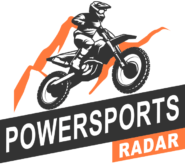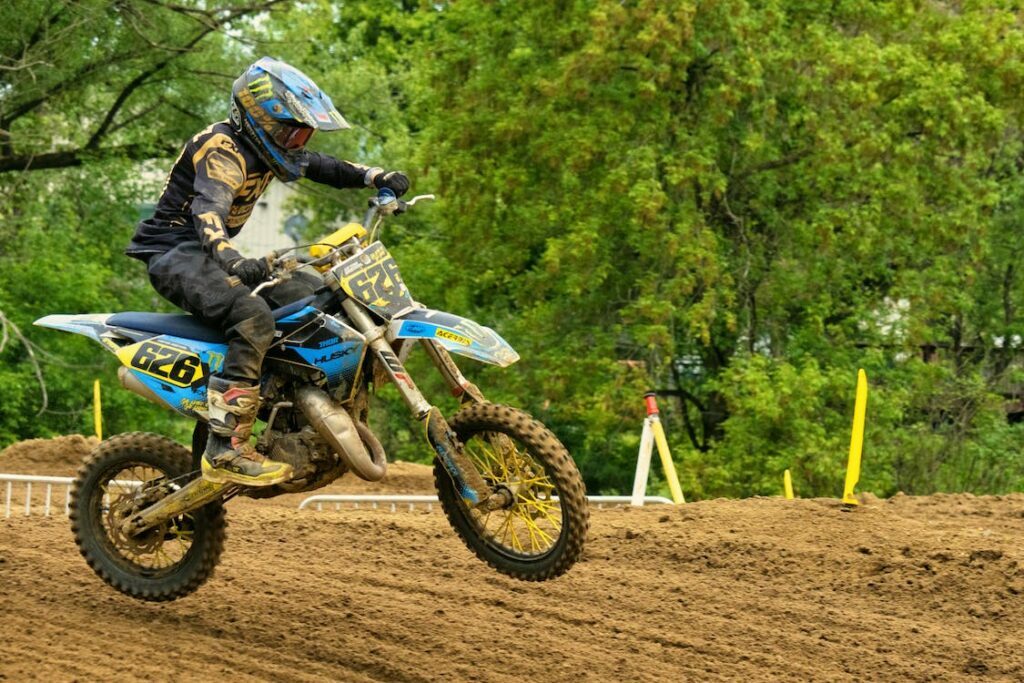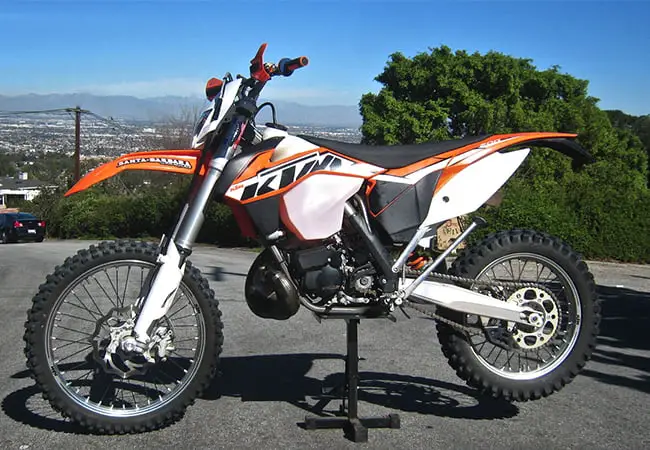Are you excited to start dirt biking but overwhelmed because you don’t know what dirt bike to get?
Don’t worry – you’re not alone!
I know how exciting it is to start this awesome sport, but I also remember the challenges of choosing the right dirt bike.
So, let me give you a helpful guide to make this process easier.
To answer the question, What dirt bike should I get? – there is no one-size-fits-all answer.
Many factors come into play, such as your riding experience, the type of riding you plan to do, your budget, and more.
That’s why it’s essential to ask the right questions and do your research to make an informed decision.
In this article, we’ll discuss the right questions to ask yourself when choosing the best dirt bike for you.
We’ll also discuss the three steps to make the right decision.
By the end of this post, you’ll have a good idea of what dirt bike you need and be confident in your decision-making process.
The Different Types of Dirt Bikes
Choosing the right dirt bike for your needs is important, and with so many different types of bikes available, it can be overwhelming.
Let’s go over the most popular types of dirt bikes to help you make a more informed decision.
Motocross
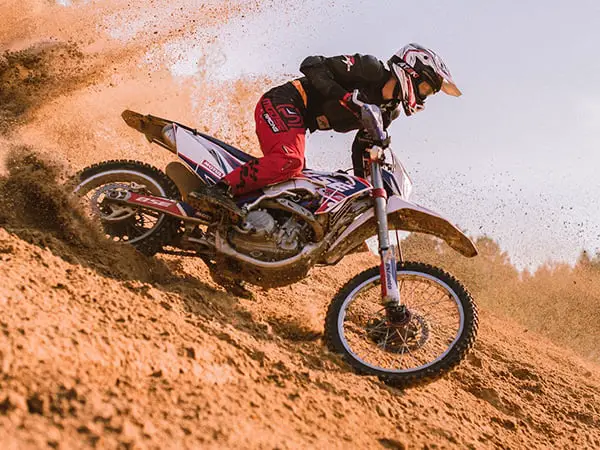
Motocross bikes are built for speed and specifically designed for racing on motocross tracks with dirt, gravel, and jumps.
These bikes have powerful, single-cylinder engines and can reach top speeds of 60 miles per hour or more.
They’re great for experienced riders who like high speeds and aggressive riding.
Trail

Trail dirt bikes are suitable for trail riding, camping, and exploring.
They are lightweight, easy to handle, and have a comfortable riding position that makes it easier to control the bike on tricky terrain.
They’re suitable for beginners and experienced riders.
Enduro
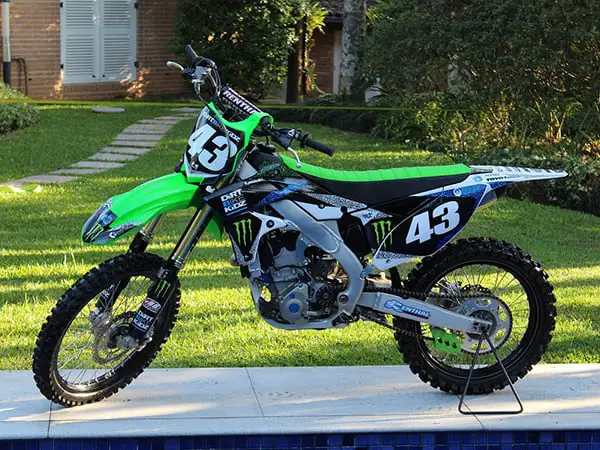
Enduro bikes are versatile machines that handle both on- and off-road riding.
They’re designed to navigate rough terrains like rocky paths, steep hills, and muddy trails while handling smooth surfaces like pavement.
Enduro bikes are appropriate for riders who enjoy adventure and exploring new places.
Dual sport
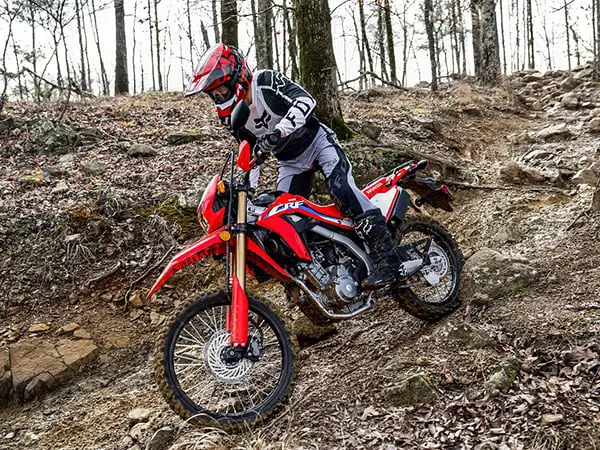
Dual sport dirt bikes are some of the most versatile and fun dirt bikes out there.
They’re designed for both on- and off-road riding, making them perfect for riders, who enjoy exploring different terrains.
Supermoto
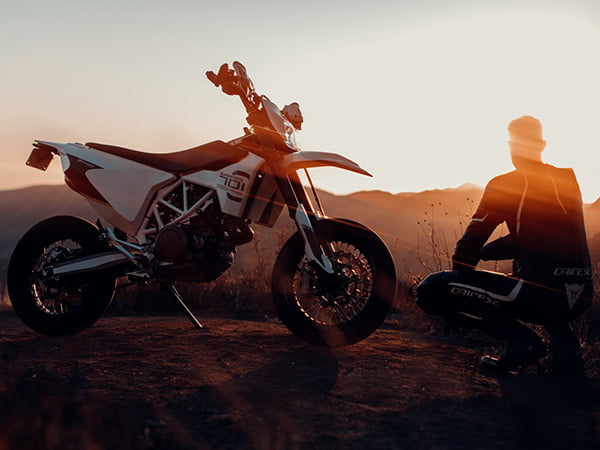
Supermoto bikes are a combination of dirt bikes and street bikes, designed for high-speed riding on dirt and pavement.
They’re suitable for riders who want the best of both worlds and have larger wheels and tires than standard dirt bikes.
7 Questions to Ask Yourself When Choosing the Right Dirt Bike
Making the right choice is all about asking yourself some pertinent questions.
So before you start your research, ask these seven questions to yourself.
These will help you narrow your options and choose the best dirt bike for your needs.
1. What is my skill level?
It’s essential to be honest about your experience with dirt bikes so far. So, ask yourself a few questions.
Have you ridden a dirt bike before? How often do you ride, and are you comfortable with high speeds and steep inclines?
For beginners, look for bikes that are easy to handle and forgiving.
These include dirt bikes with smaller engines, lower seat heights, and lighter weight, which are more manageable and simpler to control.
By starting with an easy-to-ride bike, you can build your confidence and skills as you learn.
Intermediate and advanced riders, on the other hand, may prefer bikes with more powerful engines.
These bikes are faster and more challenging to ride, making them suitable for experienced riders who are comfortable pushing their limits.
It’s important to be realistic about your skill level when selecting a dirt bike.
Riding a bike that’s too advanced for your abilities can be dangerous and cause serious injuries.
At the same time, choosing a bike that’s too easy for you can quickly become boring.
2. What is my budget?
Although it may not be the most fun question, it’s important to be honest about your financial situation.
Dirt biking can be expensive, and it’s essential to consider the cost of accessories, maintenance, repairs, and upgrades in addition to the initial purchase price.
To determine your budget, consider how much you can realistically afford to spend.
Don’t be tempted to overspend.
A used bike can be an ideal option if you’re on a tight budget, as long as you buy from a reputable seller.
3. What type of riding will I be doing?
You need to know what type of riding you’ll do before choosing a dirt bike.
This will help you find a bike that can handle the terrain and help you reach your goals.
For off-road riding, look for a bike with more suspension travel and knobby tires.
For motocross or track riding, a bike with a lighter frame and more power is ideal.
4. What is my body type and size?
Finding the right size and style of dirt bike is crucial to ensure comfort and control while riding.
A bike that is too tall or small for your body can be difficult to ride and handle.
When choosing a bike size, consider your height, weight, and body type.
For instance, smaller riders may prefer a lighter bike with a lower seat height.
In contrast, larger riders may need more of a bike with a higher seat height.
Dirt bikes are categorized by engine size, measured in cubic centimeters (cc).
Engine size affects both the bike’s power and its weight.
If you’re a beginner or plan to ride on more technical terrain, a smaller engine size, such as 125cc or 250cc, might be more suitable.
These bikes are generally lighter and easier to handle.
On the other hand, if you’re a more experienced rider or plan to ride in rougher terrain, a larger engine size, such as 250cc and above, may be more appropriate.
5. Should I buy a new or used bike?
If you’re on a tight budget, a used bike might be a more practical option.
However, you should inspect it carefully to ensure you’re not getting a lemon.
Check the maintenance records, look for signs of wear and tear, and test-ride it if possible.
If you have the budget, a brand-new bike can be an excellent investment.
It’ll come with the latest features and technology, and you’ll have peace of mind knowing it’s in top condition.
Plus, newly-released bikes usually come with a warranty, which is reassuring.
6. What is the maintenance required for the bike I’m considering?
It’s worthwhile to consider how much maintenance you’re willing to do and what kind of maintenance is required for the bike you’re considering.
Start by researching the recommended maintenance schedule for the bike you’re interested in.
Different bikes require different types of maintenance, and some may need more frequent attention than others.
Next, consider the cost of parts and repairs for the bike.
Some models may have parts that are more expensive or difficult to find than others, which could affect the overall cost of ownership.
You’ll also want to consider any repair costs from normal wear and tear or accidents.
Finally, think about your own mechanical abilities and how comfortable you are performing maintenance and repairs yourself.
If you’re not confident in your abilities, you may need to factor in the cost of hiring a mechanic for routine maintenance and repairs.
7. What is the availability of parts and service in my area?
Even the finest bikes need regular maintenance and replacement parts, and it can be frustrating if you can’t find what you need easily.
To avoid this, start by researching the availability of parts and services for the bike you’re considering.
Check with local dealerships and repair shops for brands and models they specialize in.
It’s also worth exploring online forums and reviews to learn about other riders’ experiences.
Consider the availability of aftermarket parts, as some brands and models have more options than others.
If you plan on modifying or upgrading your bike, this is something to remember.
How to choose the right dirt bike
Now that you’ve answered the questions above, it’s time to choose potential candidates for your dirt bike!
Here are three surefire steps to help you choose the right dirt bike for your riding preference and skill level in the fastest and easiest way possible.
1. Do your research
Research is key when choosing the right dirt bike!
Luckily, there are plenty of online resources that can help you make an informed decision.
Check out blogs, YouTube channels, and online forums to learn about different brands and their specs.
Compare them to your preferences and riding plans.
Visiting dealerships is also an excellent way to get up close and personal with potential dirt bikes.
You can ask salespeople questions, test ride bikes, and get a better idea of how they feel.
If you’re considering a used dirt bike, check its history before purchasing.
Check the VIN number and ask for maintenance records and information about any aftermarket parts installed.
Finally, check the availability of parts and accessories in your area to ensure you can maintain and upgrade your bike in the future.
2. Do a test ride
A test ride is essential when choosing the right dirt bike.
It allows you to feel how the bike handles and determine if it suits your riding style and preferences.
If you’re buying a brand-new bike, look for a dealership that offers test rides.
Most dealerships have demo models available for test rides.
Test the bike’s suspension, brakes, acceleration, and handling, and ask the dealership any questions about the bike.
For a used bike, renting the same model or similar dirt bike from a rental shop is an ideal option for a test ride.
Renting a bike allows you to experience the bike in similar environments and conditions you plan to ride in.
Safety should always be your top priority when doing a test ride.
Make sure to wear your dirt bike gear, including a helmet, goggles, gloves, boots, and the appropriate protective clothing.
3. Ask for opinions
It’s always a wise idea to get a second opinion before making a big purchase like a dirt bike.
Other riders can offer valuable insight based on their experiences with different models.
You can ask your local riding community or check out online forums.
This is where riders gather to discuss their experiences with various dirt bike models.
Be sure to provide as much information as possible about the riding you plan to do, your experience level, and your budget so the responses you receive are tailored to your specific needs.
Your local mechanics can also offer valuable advice on dirt bike reliability.
These experts work on bikes everyday, so they’ll know which models are reliable and which have more problems.
Wrapping up
And there you have it, folks! I hope this blog post helped you answer the question of what dirt bike to get.
Remember to take your time when researching and deciding what bike to purchase.
A dirt bike is a significant investment, and you want to make sure you get the best value for your money.
Aside from investing in the right dirt bike, also invest in high-quality dirt bike gear.
Trust me – the proper gear makes a huge difference in your safety and comfort.
Finally, have fun and enjoy the ride.
Dirt biking is an exciting and adrenaline-pumping activity that I’m sure you’ll love. Ride safely and happy dirt biking!
